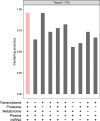Evaluating the performance of multi-omics integration: a thyroid toxicity case study
- PMID: 39441382
- PMCID: PMC11742338
- DOI: 10.1007/s00204-024-03876-2
Evaluating the performance of multi-omics integration: a thyroid toxicity case study
Abstract
Multi-omics data integration has been repeatedly discussed as the way forward to more comprehensively cover the molecular responses of cells or organisms to chemical exposure in systems toxicology and regulatory risk assessment. In Canzler et al. (Arch Toxicol 94(2):371-388. https://doi.org/10.1007/s00204-020-02656-y ), we reviewed the state of the art in applying multi-omics approaches in toxicological research and chemical risk assessment. We developed best practices for the experimental design of multi-omics studies, omics data acquisition, and subsequent omics data integration. We found that multi-omics data sets for toxicological research questions were generally rare, with no data sets comprising more than two omics layers adhering to these best practices. Due to these limitations, we could not fully assess the benefits of different data integration approaches or quantitatively evaluate the contribution of various omics layers for toxicological research questions. Here, we report on a multi-omics study on thyroid toxicity that we conducted in compliance with these best practices. We induced direct and indirect thyroid toxicity through Propylthiouracil (PTU) and Phenytoin, respectively, in a 28-day plus 14-day recovery oral rat toxicity study. We collected clinical and histopathological data and six omics layers, including the long and short transcriptome, proteome, phosphoproteome, and metabolome from plasma, thyroid, and liver. We demonstrate that the multi-omics approach is superior to single-omics in detecting responses at the regulatory pathway level. We also show how combining omics data with clinical and histopathological parameters facilitates the interpretation of the data. Furthermore, we illustrate how multi-omics integration can hint at the involvement of non-coding RNAs in post-transcriptional regulation. Also, we show that multi-omics facilitates grouping, and we assess how much information individual and combinations of omics layers contribute to this approach.
Keywords: Chemical exposure; Data integration; Multi-omics; Risk assessment; Toxicology.
© 2024. The Author(s).
Conflict of interest statement
Declarations. Conflict of interest: The authors declare that they have no potential conflict of interest.
Figures





Similar articles
-
Systemic pharmacological treatments for chronic plaque psoriasis: a network meta-analysis.Cochrane Database Syst Rev. 2021 Apr 19;4(4):CD011535. doi: 10.1002/14651858.CD011535.pub4. Cochrane Database Syst Rev. 2021. Update in: Cochrane Database Syst Rev. 2022 May 23;5:CD011535. doi: 10.1002/14651858.CD011535.pub5. PMID: 33871055 Free PMC article. Updated.
-
Systemic pharmacological treatments for chronic plaque psoriasis: a network meta-analysis.Cochrane Database Syst Rev. 2020 Jan 9;1(1):CD011535. doi: 10.1002/14651858.CD011535.pub3. Cochrane Database Syst Rev. 2020. Update in: Cochrane Database Syst Rev. 2021 Apr 19;4:CD011535. doi: 10.1002/14651858.CD011535.pub4. PMID: 31917873 Free PMC article. Updated.
-
Short-Term Memory Impairment.2024 Jun 8. In: StatPearls [Internet]. Treasure Island (FL): StatPearls Publishing; 2025 Jan–. 2024 Jun 8. In: StatPearls [Internet]. Treasure Island (FL): StatPearls Publishing; 2025 Jan–. PMID: 31424720 Free Books & Documents.
-
Selenium for preventing cancer.Cochrane Database Syst Rev. 2018 Jan 29;1(1):CD005195. doi: 10.1002/14651858.CD005195.pub4. Cochrane Database Syst Rev. 2018. PMID: 29376219 Free PMC article.
-
Systemic treatments for metastatic cutaneous melanoma.Cochrane Database Syst Rev. 2018 Feb 6;2(2):CD011123. doi: 10.1002/14651858.CD011123.pub2. Cochrane Database Syst Rev. 2018. PMID: 29405038 Free PMC article.
Cited by
-
An extended miRNA repertoire in Rattus norvegicus.Front Bioinform. 2025 Mar 10;5:1545680. doi: 10.3389/fbinf.2025.1545680. eCollection 2025. Front Bioinform. 2025. PMID: 40130010 Free PMC article. No abstract available.
References
-
- Abdelkader Y, Perez-Davalos L, LeDuc R, Zahedi RP, Labouta HI (2023) Omics approaches for the assessment of biological responses to nanoparticles. Adv Drug Deliv Rev 200:114992. 10.1016/j.addr.2023.114992 - PubMed
-
- Amorim MJB, Peijnenburg W, Greco D, Saarimäki LA, Dumit VI, Bahl A, Haase A, Tran L, Hackermüller J, Canzler S, Scott-Fordsmand JJ (2023) Systems toxicology to advance human and environmental hazard assessment: a roadmap for advanced materials. Nano Today 48:101735. 10.1016/j.nantod.2022.101735 (https://www.sciencedirect.com/science/article/pii/S1748013222003632)
MeSH terms
Grants and funding
LinkOut - more resources
Full Text Sources

